Real-time personalization means instantly tailoring marketing messages to match a customer’s current behavior, preferences, or interests. It uses live data to create relevant experiences as users engage with a brand, boosting engagement, conversions, and customer satisfaction.
Key Points:
- How It Works: Combines live data collection, AI-driven decisions, and immediate delivery across channels like websites, apps, and emails.
- Requirements: Needs clean data, AI-powered tools, and team expertise to function effectively.
- Benefits:
- Increases engagement and retention: 86% of B2B and 71% of consumers expect personalized interactions.
- Drives revenue: Companies see 40% higher revenue with real-time personalization.
- Improves email performance: Personalized emails can generate 6x more revenue.
- Use Cases: Includes product recommendations, dynamic website content, and automated messaging like cart reminders.
Real-time personalization is a powerful tool for businesses aiming to meet growing customer expectations and stay competitive.
Unlocking Real Time Personalization Through Data, AI, and Communication
How Real-Time Personalization Works
Real-time personalization involves capturing, analyzing, and acting on live customer data to create tailored experiences as customers interact with your brand. This process relies on several interconnected systems working together seamlessly.
Core Components of Real-Time Personalization
Three key elements form the backbone of real-time personalization: data collection systems, decision engines, and delivery mechanisms.
- Data collection systems: These systems constantly gather information about customer behavior across various touchpoints. This includes clicks, browsing activity, purchase history, email interactions, and even location data. For example, they track how long someone spends on a product page or the platform they used to visit your site.
- Decision engines: Acting as the "brain" of the operation, these engines use artificial intelligence and machine learning to analyze incoming data and decide the best personalized response. They rely on predefined rules and predictive models to determine what content, recommendations, or offers to present in real time.
- Delivery mechanisms: These ensure the personalized decisions are implemented across different channels. Whether it's updating website content, sending a push notification, triggering an email, or customizing an in-app experience, these systems deliver the right message to the customer at the right moment.
By understanding how these components work together, it becomes clear why having a strong, interconnected system is critical for real-time personalization.
Requirements for Real-Time Personalization
To implement real-time personalization effectively, businesses need a solid infrastructure and organizational alignment.
- Data infrastructure: This is the backbone of the system. It includes customer data platforms (CDPs) that handle large data streams, cloud-based storage for instant access to customer profiles, and APIs to connect various marketing tools. The system must process data quickly to support real-time decisions.
- Integration across tools: Seamless communication between your email platform, website content management system, mobile app, social media accounts, and customer service tools is essential. Without proper integration, personalization may work on one channel but fail on another, creating a disjointed customer experience.
- AI-powered analytics: Machine learning models trained on your customer data, predictive analytics to anticipate needs, and automated testing frameworks to refine strategies are crucial for effective personalization.
- Clean, unified customer data: High-quality data is the fuel for personalization. Deduplicating records, standardizing formats, and maintaining real-time synchronization ensure that your personalization efforts are relevant and effective. Poor data quality can result in irrelevant or even counterproductive experiences.
- Technical expertise: Skilled teams are needed to manage the system. This includes developers familiar with marketing automation platforms, data engineers to maintain real-time pipelines, and marketing technologists who can bridge the gap between business goals and technical challenges.
Given the complexity of these requirements, many businesses start with simpler personalization strategies before advancing to real-time capabilities. However, investing in a well-integrated system not only improves customer experiences but also boosts conversion rates across all channels.
Benefits of Real-Time Personalization
Real-time personalization can immediately enhance customer engagement, boost revenue, and increase satisfaction, offering a clear edge over more conventional methods.
Better Customer Engagement and Retention
When content aligns with a customer’s immediate interests, it naturally leads to higher engagement and encourages repeat visits.
Consider this: 86% of B2B customers expect personalized interactions, and 83% are willing to share more data to receive them. On the consumer side, 71% expect personalized content, while 67% feel frustrated when their experience lacks a personal touch. This disconnect often pushes customers toward brands that better understand their needs.
Real-time personalization helps close this gap by delivering experiences tailored to a customer’s current situation. For instance, if someone is browsing winter coats on a cold Tuesday, they might receive seasonal recommendations right away - plus a seamless follow-up when they return to the site.
Higher Conversion Rates and Revenue
The financial impact of real-time personalization is hard to ignore. Companies using this approach typically see 40% higher revenue compared to their competitors. This is driven by higher conversion rates, increased average order values, and more frequent purchases.
Email marketing is a standout example. Hyper-personalized campaigns can deliver response rates and revenue per email six times higher than non-personalized ones. Businesses leveraging AI for cold email personalization have reported response rates as high as 35%, which is seven times better than traditional methods.
Additionally, real-time personalization can lead to a 142% increase in response rates and a 6x boost in revenue per email. Beyond revenue, personalization also improves cost efficiency. Simple tweaks to make communications more relevant can reduce customer acquisition costs by up to 50% and increase marketing ROI by 10–30%.
Real-Time vs. Standard Personalization Comparison
Choosing between real-time and standard personalization depends on your business goals, resources, and technical capabilities. Here’s a side-by-side comparison to clarify the differences:
| Aspect | Standard Personalization | Real-Time Personalization |
|---|---|---|
| Data Source | Historical data and basic demographics | Live behavioral data and real-time interactions |
| Response Time | Hours to days for implementation | Instant response to customer actions |
| Email Performance | Open rates up 35–50%, click rates up 139% | Response rates up 142%, revenue per email up 6x |
| Revenue Impact | 10–30% marketing ROI boost | 40% higher revenue compared to competitors |
| Customer Acquisition | Moderate conversion improvements | Up to 50% lower acquisition costs |
| Implementation Complexity | Moderate setup with existing tools | Requires advanced AI systems |
| Personalization Depth | Segment-based messaging and basic customization | Individual-level customization based on behavior |
While standard personalization offers meaningful improvements with moderate effort, real-time personalization delivers unparalleled results for businesses ready to invest in advanced tools. Both approaches outperform generic marketing, but as customer expectations evolve and technology becomes more accessible, real-time personalization is quickly becoming a must-have strategy.
Up next, we’ll dive into real-world examples that showcase the power of these benefits.
sbb-itb-a84ebc4
Real-Time Personalization Use Cases
Practical applications of real-time personalization show how it can transform customer interactions across different platforms and touchpoints.
E-Commerce Product Recommendations
Online retailers are moving beyond static data by offering product suggestions based on live customer behavior. For instance, a major online retailer uses a recommendation engine that analyzes browsing patterns, page engagement, and cart activity in real time to suggest products tailored to each shopper. Similarly, a popular beauty brand combines browsing history, past purchases, and current search inputs to recommend items that match a visitor's preferences. Even streaming services tap into real-time data, using viewing habits to recommend content that aligns with what users are watching at that moment.
Dynamic Website and App Content
Websites and mobile apps can now adapt their content instantly based on user behavior. For example, a music streaming platform customizes its homepage using recent listening habits, the time of day, and even location to curate playlists and content. News websites do something similar, rearranging their homepage to highlight articles and features that match the visitor's interests and engagement. Travel platforms also use real-time insights to adjust search results and recommendations, ensuring they reflect a user’s current preferences and search activity. This type of adaptability extends to messaging strategies, creating more meaningful interactions across channels.
Automated Messaging Across Channels
Real-time personalization also shines in automated messaging. For example, abandoned cart messages are triggered instantly, encouraging customers to complete their purchases. Other triggers, like milestone messages or browse abandonment notifications, help strengthen customer relationships and drive conversions. By coordinating these messages across email, SMS, push notifications, and social media, businesses can maintain a consistent and engaging experience without overwhelming users.
These examples highlight how real-time personalization not only enhances customer experiences but also fine-tunes each stage of the marketing funnel, meeting customer needs as they arise and paving the way for more integrated strategies.
Adding Real-Time Personalization to Your Marketing Funnel
Real-time personalization is changing the way businesses guide customers through their marketing funnels. It allows companies to adapt to individual behaviors and preferences as they happen, creating a smoother, more engaging journey for each customer.
Real-Time Personalization by Funnel Stage
Awareness Stage: This is all about grabbing attention with content that speaks directly to new visitors. By analyzing cues like location, referral source, and browsing behavior, businesses can present content that feels relevant right away. For instance, if someone clicks on a social media ad about sustainable fashion, they might see homepage banners and featured products that highlight eco-friendly options and the brand’s commitment to sustainability. Personalization can also adapt based on the visitor’s device - mobile users might see streamlined, quick-access content, while desktop users could get more in-depth product details since they’re likely to spend more time exploring.
Consideration Stage: At this point, personalization digs deeper into visitor behavior. As users engage - whether by browsing specific categories or downloading resources - real-time systems track these actions to fine-tune the experience. For example, visitors might be shown product comparisons, customer testimonials, or educational content tailored to their interests. Even email campaigns can adjust based on what links recipients click, ensuring follow-ups feel relevant and not like generic promotions.
Decision Stage: Here, the goal is to seal the deal. Real-time personalization can display limited-time offers for price-sensitive shoppers, highlight trust signals like security badges for first-time buyers, or show customer reviews from people with similar preferences. If someone abandons their cart, follow-up messages can reference the exact items they left behind, paired with personalized incentives or reminders based on their browsing and purchase history.
The beauty of this approach is its ability to adapt as customers move through the funnel. A casual browser at the awareness stage might initially receive educational content, but as their interest grows, the system seamlessly shifts to offering detailed product information and tools to help them decide.
To execute this strategy effectively, businesses need the right tools and resources. The next section introduces a resource hub to help implement these personalized funnel strategies.
Using the Marketing Funnels Directory for Implementation

To bring these strategies to life, the Marketing Funnels Directory offers a one-stop resource for businesses interested in real-time personalization. This directory includes tools, vendors, courses, and books designed to help companies create highly personalized marketing funnels.
The directory features software and vendor listings that cover a range of personalization needs - from straightforward tools to advanced customer data platforms capable of integrating across multiple channels. It’s organized by funnel stage and functionality, making it easy to find solutions tailored to specific business goals or technical requirements.
Additionally, the directory includes courses and books that dive into the nitty-gritty of implementing personalization strategies. These resources not only cover the technical side - like collecting and using real-time data - but also explore the psychology behind why personalized experiences resonate with customers. They even address critical topics like maintaining customer privacy and trust.
For businesses with unique channel needs, the directory provides dedicated sections for social media, ads, content, and B2B funnels. For example, social media personalization might focus on dynamic ad creatives and audience segmentation, while B2B funnels often prioritize account-based approaches, considering factors like company size, industry, and decision-making processes. This structure ensures businesses can tailor their strategies to move customers from awareness to decision across all channels effectively.
Conclusion
Real-time personalization is changing the way businesses connect with their customers. By adapting to customer behaviors, preferences, and needs as they happen, it creates a more tailored and engaging experience.
The benefits are hard to ignore: higher engagement, better conversion rates, and stronger customer loyalty. When users feel like a website or app truly "gets" them, they’re more likely to stick around, explore, and make a purchase.
What sets real-time personalization apart is its ability to adjust and refine with every interaction. This dynamic approach keeps messaging relevant at every stage of the customer journey, ensuring that businesses stay in tune with their audience.
Its applications span across industries and channels. E-commerce platforms use it for personalized product recommendations, content platforms suggest articles based on user interests, and email campaigns target users with messages tailored to their recent activity. To make all this work, businesses need reliable data collection, analytics, and content management tools that can respond instantly to customer actions.
To fully tap into these benefits, having the right tools and resources is crucial. The Marketing Funnels Directory offers a curated selection of software, educational materials, and strategic guides to help businesses craft effective personalized marketing funnels. Whether you’re working on social media campaigns, B2B outreach, or e-commerce strategies, this directory provides actionable resources to enhance your efforts.
In today’s competitive landscape, real-time personalization isn’t just a nice-to-have - it’s a must. Customers now expect timely, relevant interactions, and businesses that deliver will stand out, build lasting relationships, and drive growth.
FAQs
How can businesses build the right data infrastructure for real-time personalization?
To build a solid foundation for real-time personalization, businesses must focus on systems that allow effortless data collection, integration, and instant analysis. This means using tools that pull customer data from various sources, match identities across platforms, and leverage analytics to create personalized experiences as they happen.
A key component is real-time data streaming, which enables businesses to adjust content and offers based on customers' live actions. With scalable and dependable technology in place, companies can make quicker, better-targeted decisions that boost customer engagement and deliver stronger outcomes.
What challenges do businesses face with real-time personalization, and how can they solve them?
Businesses frequently face hurdles when it comes to data management, particularly in merging accurate and current information from various sources. Maintaining high-quality, relevant data is essential for delivering personalized experiences that truly resonate with customers. On top of that, privacy concerns pose another significant challenge, as customers want tailored interactions without sacrificing their sense of security or privacy.
To tackle these challenges, companies must invest in a solid data infrastructure capable of handling real-time processing while adhering to clear and transparent privacy policies. Striking the right balance in personalization is equally important - brands should focus on creating relevant experiences without veering into over-personalization, which can feel invasive or even damage their reputation.
How does real-time personalization affect customer privacy, and what can businesses do to build trust?
Real-time personalization often walks a fine line between enhancing user experience and raising privacy concerns. This is because it relies on collecting and analyzing customer data to create tailored interactions. If mishandled, it can erode customer trust.
To safeguard trust, businesses need to be upfront about their practices. Clearly communicate how customer data is gathered, stored, and utilized. Following privacy laws like GDPR or CCPA is non-negotiable, and offering customers the ability to opt in or out of personalization is crucial. By prioritizing privacy and honoring customer choices, companies can foster stronger, trust-filled connections with their audience.


